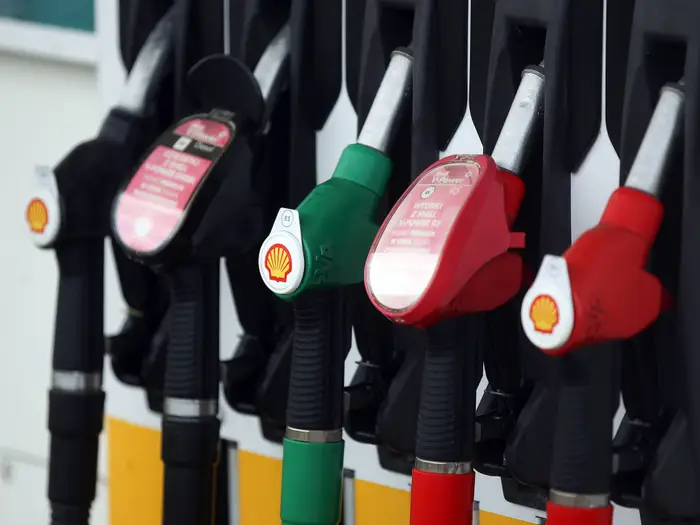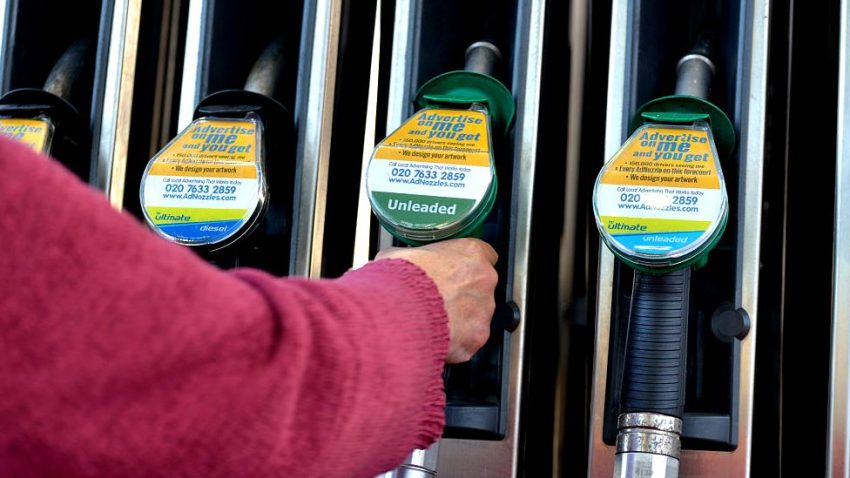Yes, in the United Kingdom, petrol pumps (gas pumps) are equipped with an automatic shut-off mechanism. This mechanism is designed to stop the flow of fuel when the vehicle’s fuel tank is full. It helps prevent overfilling, spills, and related safety hazards.
In this article, you’ll take a simple look at why petrol pumps in the UK stop automatically
How Petrol Pumps Work
1. Fuel Storage Tank: Petrol pumps are equipped with underground fuel storage tanks that store different types of fuels, such as gasoline, diesel, and sometimes alternative fuels like ethanol or compressed natural gas (CNG). These are usually buried below the ground to ensure safety and maintain a consistent temperature for the fuel.
2. Pumping Mechanism: When you pull up to a petrol pump and select the type of fuel you need, the pumping mechanism is activated. Modern ones are often equipped with electronic systems, while older ones may have manual pumps. In both cases, the process begins with the activation of a submersible pump that draws fuel from the storage tank.
3. Fuel Filtration: The fuel drawn from the storage tank passes through filtration systems to remove impurities and water, ensuring that it is clean and safe for your vehicle’s engine.
4. Transport to the Dispensing Unit: Although, it is transported through a network of pipes and hoses to the dispensing unit, which is part of the petrol pump where you fill up your vehicle. Here, it is held in a secure chamber, ready for dispensing.
5. Dispensing Nozzle and Hose: The dispensing nozzle is what you hold in your hand to fill your vehicle’s fuel tank. It is connected to a hose that carries it. The nozzle typically has safety features, including an automatic shut-off mechanism to prevent overfilling and spills. This mechanism is triggered when the vehicle is full.
6. Payment System and Display: Modern petrol pumps have electronic payment systems. You can choose your fuel grade, start the dispensing process, and monitor the amount being pumped through a digital display. When you’ve finished refueling, you can complete your payment using various methods, such as credit or debit cards, mobile apps, or cash.
7. Safety Measures: They are equipped with several safety measures to prevent accidents and protect the environment. These may include emergency stop buttons, fire suppression systems, and safety interlocks.
8. Regular Maintenance: lastly, they require regular maintenance to ensure they function correctly and safely. This maintenance includes checking for leaks, inspecting safety features, and calibrating the dispensing unit to accurately measure fuel.
Automatic Shut-off Mechanism: Ensuring Safety and Efficiency in Petrol Pumps

1. Sensing Fuel Level: Inside the nozzle of the fuel dispensing system, there is a sensor designed to detect the level in the receiving vehicle’s tank. It is often a simple float mechanism or a more sophisticated electronic sensor.
2. Triggering the Shut-off: As the fuel level in the vehicle’s tank rises during refueling, the sensor continuously monitors the level. When the tank is nearly full, the sensor signals the pump to stop dispensing fuel.
3. Prevention of Overfilling: The automatic shut-off mechanism is designed to prevent overfilling the vehicle’s fuel tank. Overfilling can be dangerous as it may lead to spillage, which is not only a safety hazard but can also harm the environment.
4. Audible and Visual Signals: In many petrol pumps, there are audible and visual signals to alert the user when it is activated. This may include a clicking sound or a visual indicator on the pump’s display.
5. User Responsibility: While the automatic shut-off mechanism is a crucial safety feature, it’s important for the user to be attentive during refueling. They should be ready to stop the process manually if the shut-off mechanism fails to work or if there are any irregularities.
6. Occasional Failures: Although these are designed to work reliably, they can occasionally fail due to sensor issues or other malfunctions. Users should be aware of this and be prepared to take action if needed.
Reasons for Automatic Shutdown
The automatic shutdown mechanism in petrol pumps plays a crucial role in enhancing safety, environmental protection, and user convenience. Its primary function is to prevent overfilling of vehicle fuel tanks, reducing the risk of spills and related safety hazards.
Furthermore, overfilling can lead to fuel splashing back, potentially causing harm to individuals refueling and even posing a fire hazard in extreme cases. Moreover, the mechanism minimizes the environmental impact by reducing the chances of fuel spills that can contaminate soil and water sources, affecting ecosystems and wildlife.
Additionally, it promotes regulatory compliance with fueling safety and environmental standards, helping petrol station owners and operators avoid fines and legal consequences. In ensuring efficient fuel usage, it prevents unnecessary fuel overflow, ultimately saving resources and money for both consumers and petrol station operators.
Lastly, it enhances user convenience, allowing individuals to start the refueling process and attend to other tasks or distractions, secure in the knowledge that it will stop fuel flow once the tank is full.
Legal and Regulatory Framework

Below are key aspects of the legal and regulatory framework for petrol pumps in the UK:
Petroleum Acts: The primary legislation governing petrol pumps in the UK includes the Petroleum (Consolidation) Act 1928, the Petroleum (Transfer of Licences) Act 1936, and the Petroleum (Regulation) Act 1949. These acts set out the legal requirements and regulations for the storage, handling, and distribution of petroleum products.
Petroleum Licensing: Fuel station owners and operators must obtain the necessary licenses and permits to store, handle, and distribute petroleum products. These lare typically issued by local authorities or environmental agencies.
Health and Safety Regulations: The Health and Safety at Work Act 1974 and associated regulations, such as the Dangerous Substances and Explosive Atmospheres Regulations 2002 (DSEAR), govern health and safety at petrol stations. These regulations cover the safe operation of fuel pumps, storage tanks, and safety measures to protect workers and customers.
Environmental Regulations: in the UK, such as the Environmental Protection Act 1990 and the Environmental Permitting (England and Wales) Regulations 2010, set standards for preventing environmental pollution, including the safe storage and handling of petroleum products.
Weights and Measures Regulations: It Act 1985 and the Weights and Measures Regulations 2006 regulate the accuracy of fuel dispensers, ensuring that customers receive the correct quantity of fuel for the price paid. Regular inspections and calibrations are required to comply with these regulations.
Fire Safety Regulations: including the Regulatory Reform (Fire Safety) Order 2005, require petrol stations to have appropriate fire safety measures in place to prevent and mitigate the risk of fires, including the installation of fire suppression systems and safety equipment.
Consumer Protection: The laws, such as the Consumer Rights Act 2015, ensure that consumers are provided with accurate information about fuel prices, quality, and safety. Fuel station operators must adhere to these regulations to protect consumer rights.
Transportation Regulations: The Carriage of Dangerous Goods and Use of Transportable Pressure Equipment Regulations 2009 (CDG) govern the transportation of dangerous goods, including the safe delivery of petroleum products to fuel stations.
Local Authority Regulations: They have the power to set specific requirements and conditions for petrol stations within their jurisdictions, such as zoning and planning regulations.
Accessibility Regulations: like the Equality Act 2010, require petrol stations to provide access for people with disabilities, including accessible fuel pumps and service areas.
FAQs
1. Does the petrol pump stop when it’s full in the UK?
Yes, petrol pumps in the UK stop automatically when they sense that the tank is full to prevent overfilling.
2. Do petrol pumps turn off automatically?
Yes, petrol pumps turn off automatically using an automatic shutoff feature.
3. Do all petrol pumps stop when full?
Most petrol pumps are designed to stop automatically when the tank is full, but there can be some variations in older or non-standard pumps.
4. Why does the petrol pump keep clicking off in the UK?
The clicking off occurs when the automatic shutoff feature senses a full tank or detects a safety issue.
5. What happens if you run out of fuel in the UK?
If you run out of fuel in the UK, you’ll need to refuel or seek assistance, such as roadside service.
6. Why don’t UK petrol pumps lock?
UK petrol pumps typically lack a latch mechanism for safety reasons.
7. Do fuel pumps know when to stop?
Yes, fuel pumps are equipped with sensors that detect when the tank is full and trigger the automatic shutoff.
8. Do fuel pumps stay on?
No, fuel pumps automatically stop when they sense the tank is full.
9. What happens when the fuel pump stops?
When the fuel pump stops, it means your tank is full or there might be an issue with the pump’s safety mechanisms.
Final Words:
In conclusion, the automatic shut-off feature in UK petrol pumps is a fundamental safety mechanism designed to prevent overfilling, spills, and related hazards during the refueling process. This vital safety measure not only protects individuals and their vehicles but also safeguards the environment by reducing the risk of fuel spills.
Furthermore, it ensures compliance with regulatory standards and efficiency in fuel usage, thereby benefiting both consumers and petrol station operators. The automatic shut-off mechanism represents a commitment to safety, environmental responsibility, and user convenience, making it an integral part of the petrol station experience in the United Kingdom.

